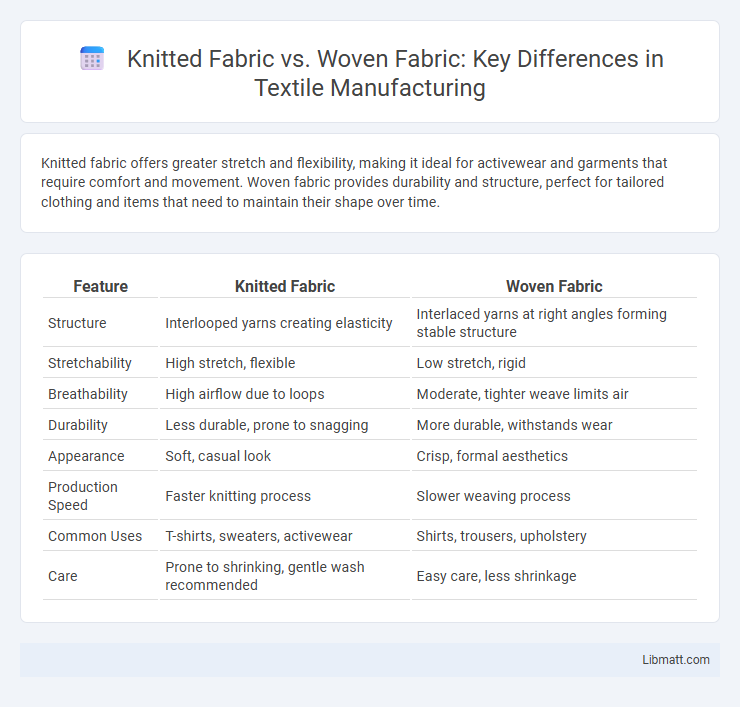Knitted fabric offers greater stretch and flexibility, making it ideal for activewear and garments that require comfort and movement. Woven fabric provides durability and structure, perfect for tailored clothing and items that need to maintain their shape over time.
Table of Comparison
| Feature | Knitted Fabric | Woven Fabric |
|---|---|---|
| Structure | Interlooped yarns creating elasticity | Interlaced yarns at right angles forming stable structure |
| Stretchability | High stretch, flexible | Low stretch, rigid |
| Breathability | High airflow due to loops | Moderate, tighter weave limits air |
| Durability | Less durable, prone to snagging | More durable, withstands wear |
| Appearance | Soft, casual look | Crisp, formal aesthetics |
| Production Speed | Faster knitting process | Slower weaving process |
| Common Uses | T-shirts, sweaters, activewear | Shirts, trousers, upholstery |
| Care | Prone to shrinking, gentle wash recommended | Easy care, less shrinkage |
Introduction to Knitted and Woven Fabrics
Knitted fabric consists of interlocking loops of yarn, offering superior stretch and elasticity, making it ideal for activewear and casual clothing. Woven fabric features perpendicular yarns tightly interlaced in warp and weft patterns, providing durability and structure often used in formal wear and upholstery. Understanding the differences between knitted and woven fabrics helps you choose the right material for comfort, functionality, and appearance.
Understanding Fabric Construction Methods
Knitted fabric consists of interlocking loops of yarn, providing greater elasticity and stretch, making it ideal for garments requiring flexibility like t-shirts and activewear. Woven fabric is made by interlacing two sets of yarns--warp and weft--at right angles, resulting in a stable, less stretchy material commonly used in shirts, trousers, and upholstery. The distinct construction methods influence fabric behavior, durability, drape, and comfort, guiding designers in selecting textiles for specific applications.
Key Differences Between Knitted and Woven Fabrics
Knitted fabrics consist of interlocking loops of yarn, providing superior stretch and elasticity compared to woven fabrics, which are made by crossing yarns at right angles, resulting in a more rigid and structured material. The breathable nature of knitted fabrics makes them ideal for activewear, while woven fabrics excel in durability and are commonly used for tailored garments. Care differences also exist, with knitted fabrics requiring careful handling to avoid distortion and woven fabrics generally being more resistant to wear and tear.
Texture and Appearance Comparison
Knitted fabric features a looped structure that creates a soft, stretchy texture with a breathable surface ideal for comfort wear, while woven fabric is constructed with interlaced threads forming a tighter, smoother texture that offers durability and a more polished appearance. The texture of knitted fabrics tends to be more flexible and elastic, making them suitable for casual and activewear, whereas woven fabrics provide a firm hand and structured look preferred in formal garments and upholstery. Visually, knitted fabrics display visible loops and a slightly uneven surface, contrasting with the uniform grid-like pattern and sleek finish of woven fabrics.
Stretchability and Flexibility
Knitted fabric exhibits superior stretchability and flexibility due to its looped construction, allowing it to expand and contract with ease, which makes it ideal for activewear and garments requiring high mobility. Woven fabric, created by interlacing threads at right angles, offers less natural stretch but provides better structural stability and durability, favoring applications where shape retention is crucial. The elastic recovery in knitted fabrics significantly surpasses that of woven fabrics, enhancing comfort and fit in stretch-dependent clothing items.
Durability and Strength Factors
Knitted fabric offers exceptional elasticity and stretch, making it less prone to tearing under stress, while woven fabric provides superior tensile strength due to its interlaced yarn structure. Durability in woven fabrics excels in resisting abrasion and maintaining shape over time, whereas knitted fabrics may be more susceptible to snagging but recover better from deformation. Your choice between these depends on whether you need flexible comfort or long-lasting rigidity for your specific application.
Breathability and Comfort Levels
Knitted fabric offers superior breathability due to its looped structure, allowing more air to circulate and moisture to escape compared to woven fabric. This enhances comfort levels, making knitted textiles ideal for activewear and casual clothing where flexibility and ventilation are essential. Conversely, woven fabric, with its tighter and more rigid weave, tends to trap heat and moisture, resulting in lower breathability and less comfort in warm or highly active conditions.
Common Uses and Applications
Knitted fabric, characterized by its stretch and flexibility, is commonly used in activewear, t-shirts, and casual clothing where comfort and movement are essential. Woven fabric, known for its strength and durability, is typically applied in formal wear, upholstery, and denim where structure and resilience are priorities. Your choice between knitted and woven fabric depends on the specific demands of the garment or item's use.
Care and Maintenance Tips
Knitted fabric requires gentle washing in cold water to prevent stretching, with air drying preferred to maintain its elasticity and shape. Woven fabric benefits from regular ironing at medium heat to keep fibers smooth and should be washed carefully to avoid fraying edges. Both fabrics perform best when stored folded in a cool, dry place to reduce wear and preserve their texture.
Choosing the Right Fabric: Knitted or Woven?
Knitted fabric offers superior stretch and flexibility, making it ideal for activewear, casual clothing, and garments requiring comfort and movement. Woven fabric provides durability, structure, and a crisp appearance, perfect for formal wear, shirts, and upholstery. Your choice depends on the intended use; prioritize knitted fabrics for softness and flexibility, and woven fabrics for strength and shape retention.
Knitted fabric vs Woven fabric Infographic

 libmatt.com
libmatt.com